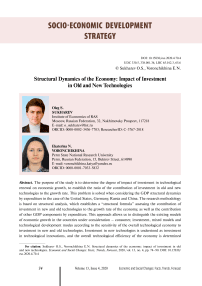Structural dynamics of the economy: impact of investment in old and new technologies
Автор: Sukharev Oleg S., Voronchikhina Ekaterina N.
Журнал: Economic and Social Changes: Facts, Trends, Forecast @volnc-esc-en
Рубрика: Socio-economic development strategy
Статья в выпуске: 4 т.13, 2020 года.
Бесплатный доступ
The purpose of the study is to determine the degree of impact of investment in technological renewal on economic growth, to establish the ratio of the contribution of investment in old and new technologies to the growth rate. This problem is solved when considering the GDP structural dynamics by expenditure in the case of the United States, Germany, Russia and China. The research methodology is based on structural analysis, which establishes a “structural formula” assessing the contribution of investment in new and old technologies to the growth rate of the economy, as well as the contribution of other GDP components by expenditure. This approach allows us to distinguish the existing models of economic growth in the countries under consideration - consumer, investment, mixed models and technological development modes according to the sensitivity of the overall technological economy to investment in new and old technologies. Investment in new technologies is understood as investment in technological innovations, and the overall technological efficiency of the economy is determined by the ratio of the volume of innovative goods shipped and the volume of non-innovative goods, works, and services. The investment breakdown method helps to assess the contribution of investment in new technologies to economic growth, both in a comparative way relative to other GDP components, and for the considered countries. The result of the study is the identification of the economic growth model by the largest contribution to GDP component in the period under review, the contribution to the rate of investment in new and old technologies, as well as the determination of the sensitivity of technology to investment in new and old technologies in the United States, Germany, China and Russia. The analysis found that the impact of investment on the GDP dynamics and the level of technology is not synchronized, which requires to change the approach to macroeconomic policy, aimed not only at stimulating investments as a driver of growth, but also their distribution in such a way which would lead to an increase in the technology of the economy together with changing the institutions.
Gdp structure by expenditure, investment, old and new technologies, manufacturability, economic growth,
Короткий адрес: https://sciup.org/147225481
IDR: 147225481 | DOI: 10.15838/esc.2020.4.70.4
Список литературы Structural dynamics of the economy: impact of investment in old and new technologies
- Gabardo F.A., Pereima J.B., Einloft P. The incorporation of structural change into growth theory: A historical appraisal. Economia, 2017, vol. 18, issue 3, pp. 392–410. http://dx.doi.org/10.1016/j.econ.2017.05.003.
- Freire C. Economic diversification: A model of structural economic dynamics and endogenous technological change. Structural Change and Economic Dynamics, 2019, vol. 49, pp. 13–28. DOI: 10.1016/j.strueco. 2019.03.005.
- Alonso-Carrera J., Raurich X. Labor mobility, structural change and economic growth. Journal of Macroeconomics, 2018, vol. 56, pp. 292–310. DOI: 10.1016/j.jmacro.2018.03.002.
- Samaniego R.M., Sun J.Y. Productivity growth and structural transformation. Review of Economic Dynamics, 2016, vol. 21, pp. 266–285. DOI: 10.1016/j.red.2015.06.003.
- Pi J., Zhang P. Structural change and wage inequality. International Review of Economics & Finance, 2018, vol. 58, pp. 699–707. DOI: https://doi.org/10.1016/j.iref.2018.07.010.
- Brancaccio E., Garbellini N., Giammetti R. Structural labour market reforms, GDP growth and the functional distribution of income. Structural Change and Economic Dynamics, 2018, vol. 44, pp. 34–45.
- Cutrini E. Economic integration, structural change, and uneven development in the European Union. Structural Change and Economic Dynamics, 2019, vol. 50, pp. 102–113. DOI: 10.1016/j.strueco.2019.06.007.
- Vu K.M. Structural change and economic growth: Empirical evidence and policy insights from Asian economies. Structural Change and Economic Dynamics, vol. 41, 2017, pp. 64–77. DOI: https://doi.org/10.1016/j.strueco.2017.04.002.
- Aghion P., Akcigit U., Howitt P. Lessons from Schumpeterian Growth Theory. The American Economic Review, 2015, vol. 105, no. 5, pp. 94–99. DOI: 10.1257/aer.p20151067.
- Breschi S., Malerba F., Orsenigo L. Technological Regimes and Schumpeterian Patterns of Innovation. The Economic Journal, 2000, vol. 110, no. 463, pp. 388–410. https://doi.org/10.1111/1468-0297.00530.
- Castellacci F. A Neo-Schumpeterian Approach to Why Growth Rates Differ. Revue économique, 2004, vol. 55, no. 6, pp. 1145–1169. DOI: 10.3917/reco.556.1145.
- Landesmann M.A., Stöllinge R. Structural change, trade and global production networks: An ‘appropriate industrial policy’ for peripheral and catching-up economies. Structural Change and Economic Dynamics, 2019, vol. 48, pp. 7–23. https://doi.org/10.1016/j.strueco.2018.04.001.
- Sukharev O.S. The Theory of Economic Growth: Institutions, Structures, Technologies and Information. Moscow, 2019a.
- Sukharev O.S. The restructuring of the investment portfolio: the risk and effect of the emergence of new combinations. Quantitative Finance and Economics, 2019b, no. 3(2), pp. 390–411. doi: 10.3934/QFE.2019.2.390.
- Sukharev O.S. Structural analysis of income and risk dynamics in models of economic growth. Quantitative Finance and Economics, 2020, vol. 4(1), pp. 1–18. DOI: 10.3934/QFE.2020001.
- Iamsiraroj S. The foreign direct investment – economic growth nexus. International Review of Economics & Finance, 2016, vol. 42, pp. 116–133. DOI: 10.1016/j.iref.2015.10.044.
- Romano L., Traù F. The nature of industrial development and the speed of structural change. Structural Change and Economic Dynamics, 2017, vol. 42, pp. 26–37. http://dx.doi.org/10.2139/ssrn.2461290.
- Brondino G. Productivity growth and structural change in China (1995–2009): A subsystems analysis. Structural Change and Economic Dynamics, 2019, vol. 49, pp. 183–191. DOI: 10.1016/j.strueco.2018.09.001.
- Vo L.V., Le H.T.T. Strategic growth option, uncertainty, and R&D investment. International Review of Financial Analysis, 2017, vol. 51, pp. 16–24. DOI: 10.1016/j.irfa.2017.03.002.
- Felice G. Size and composition of public investment, sectoral composition and growth. European Journal of Political Economy, 2016, vol. 44, pp. 136–158. DOI: 10.1016/j.ejpoleco.2016.07.001.
- Andreoni A., Chang H-J, Scazzieri R. Frontiers of Industrial Policy: Structures, Institutions and Policies. Structural Change and Economic Dynamics, 2019, vol. 48, pp. 1–150.


